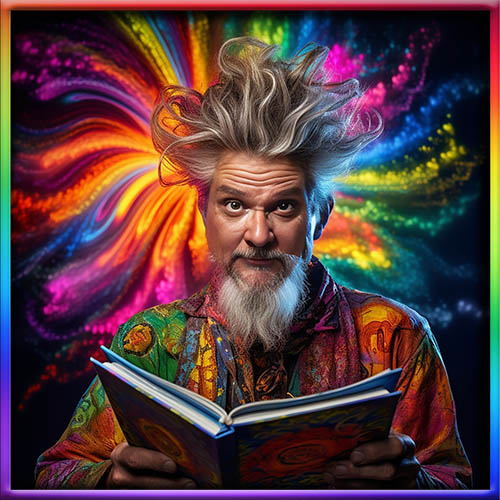
How Flow States Can Ignite Your Imagination!
Unleashing the Power Within
Exploring Hypnosis and Flow States for Personal Growth and Success

Hypnosis and flow states are intriguing psychological phenomena that have captivated researchers, practitioners, and individuals seeking personal growth and success. Hypnosis, often associated with stage shows and mysterious acts, is actually an altered state of consciousness characterized by heightened suggestibility and deep relaxation. On the other hand, flow states, popularized by psychologist Mihaly Csikszentmihalyi, refer to the optimal mental state where individuals are fully immersed in a challenging activity, experiencing a sense of complete focus and enjoyment. Exploring the concepts of hypnosis and flow states is crucial as they offer profound insights into unlocking our potential, enhancing performance, and achieving a fulfilling life.
The significance of studying hypnosis and flow states cannot be overstated. These states of mind have the potential to transform our lives, both personally and professionally. By delving into the depths of hypnosis, we can unravel the mysteries of the human mind and gain a deeper understanding of our thoughts, behaviors, and emotions. Furthermore, harnessing the power of flow states enables us to tap into our innate capabilities and achieve a heightened level of performance and productivity. By examining these concepts, we can unlock the keys to personal growth and success.
As many folks who have followed my work in trance and ecstatic states know, I have had a strong interest in how we can recreate flow states within trancework. I have taught a number of classes, workshops, and seminars in the subject over the years. Periodically, I will run exercises for students at the university in Taiwan where I am an associate professor.
The primary objective of this essay is to provide a comprehensive exploration of hypnosis and the creation and maintenance of flow states. By examining the benefits of these states of mind, we can uncover their potential to facilitate personal growth, enhance performance, and promote overall well-being. Through a deep analysis of the underlying mechanisms and techniques involved, we will gain a thorough understanding of how to induce and sustain these states effectively.
To achieve this objective, the essay will be organized as follows: First, we will delve into the understanding of hypnosis, tracing its historical roots and development as a therapeutic tool. By exploring various theories and perspectives on hypnosis, we can unravel the mechanisms behind this altered state of consciousness.
Next, we will turn our attention to the concept of flow states. Defining the characteristics of flow and its distinguishing features will provide a solid foundation for our analysis. Furthermore, we will explore the factors that contribute to the creation of flow states, such as clear goals, immediate feedback, and the delicate balance between challenge and skill level. This understanding will allow us to delve into the techniques that facilitate entering and maintaining flow states, including mindfulness, goal setting, and eliminating distractions.
Moving forward, we will examine the myriad benefits of hypnosis and flow states. On a personal level, these states offer opportunities for self-discovery and self-awareness, enabling individuals to overcome limitations, tap into their creativity, and enhance problem-solving abilities. Additionally, the essay will shed light on the positive effects of hypnosis and flow states on performance enhancement, including increased productivity, heightened focus, and improved decision-making. Furthermore, we will explore the impact of these states on stress reduction and overall well-being, highlighting their potential for relaxation, confidence-building, and positive effects on mental and physical health.
The application of hypnosis and flow states extends beyond personal realms and finds utility in various fields. This essay will delve into the application of these states in sports and athletics, exploring how mental preparation and visualization techniques can enhance performance and motivation. Additionally, we will examine the impact of hypnosis and flow states on learning and education, uncovering how these states can improve concentration, information retention, and academic success. Finally, we will explore the creative fields, where hypnosis and flow states can facilitate inspiration, break through creative blocks, and foster artistic expression.
While hypnosis and flow states offer numerous benefits, they also present challenges and ethical considerations that must be addressed. This essay will discuss potential risks, limitations, and responsible practices associated with utilizing hypnosis and flow state techniques. By acknowledging these concerns, we can ensure the responsible and safe use of these powerful tools.
The exploration of hypnosis and flow states is crucial for unlocking our potential and achieving personal growth and success. By understanding the underlying mechanisms, techniques, and benefits associated with these states, we can harness their power to transform our lives and reach new heights of achievement. The following sections of this essay will provide an in-depth analysis of hypnosis and flow states, unraveling their mysteries and showcasing their immense potential for personal and professional development.
Unlocking the Mysteries of the Mind
A Look into the Phenomenon of Hypnosis

Hypnosis, often shrouded in mystery and misconceptions within the public consciousness, is an altered state of consciousness that has been studied and utilized for centuries. To grasp the concept of hypnosis fully, it is crucial to delve into its historical roots and development as a therapeutic tool. The origins of hypnosis can be traced back to ancient civilizations, where trance-like states were used in healing rituals and religious practices. However, it wasn’t until the late 18th century that hypnosis gained recognition as a legitimate scientific and therapeutic method.
Contemporary understanding of hypnosis emphasizes its role as an altered state of consciousness that involves a heightened state of suggestibility and relaxation. It is often induced through a process called hypnotic induction, which can be facilitated by a trained hypnotherapist or through self-hypnosis techniques. During hypnosis, individuals enter a trance-like state where their attention becomes highly focused and their subconscious mind becomes more accessible to suggestions and therapeutic interventions.
Various theories attempt to explain the mechanisms underlying hypnosis. The sociocognitive theory suggests that hypnosis is a social phenomenon influenced by expectations, beliefs, and compliance with the hypnotic context. According to this theory, individuals who believe in the power of hypnosis are more likely to experience its effects. Conversely, the dissociation theory posits that hypnosis involves a state of divided consciousness where the individual’s attention is directed both internally and externally, leading to alterations in perception and responsiveness.
While the precise mechanisms of hypnosis continue to be debated, its therapeutic applications are widely recognized. Hypnosis has been successfully used in the treatment of various conditions, including pain management, phobias, smoking cessation, and anxiety disorders. Moreover, it has proven to be a valuable tool for enhancing performance, improving self-confidence, and promoting overall well-being.
Hypnosis is an altered state of consciousness that has evolved over centuries and holds immense potential for therapeutic and personal growth purposes. Understanding the historical development of hypnosis and exploring different theoretical perspectives allow us to appreciate its complexity and shed light on its practical applications. By recognizing hypnosis as a valuable tool, we can harness its power to tap into the subconscious mind and unlock our inner potential.
Diving into the Zone
Unleashing Your Full Potential through Flow States

Flow states, often described as moments of effortless concentration and complete immersion in an activity, have become a subject of fascination in psychology and personal development. Understanding the characteristics and factors that contribute to the creation of flow states is essential for harnessing their power and experiencing optimal performance and fulfillment.
Flow is characterized by a state of deep focus, where individuals are fully engaged in a task, feeling a sense of timelessness and heightened awareness. One of the key characteristics of flow is having clear goals and immediate feedback. When the objectives of an activity are well-defined and progress can be readily assessed, individuals are more likely to enter a state of flow. The clarity of goals provides a sense of purpose and direction, while immediate feedback allows for constant adjustments and improvements, maintaining the flow state.
Concentration and focused attention are crucial elements in the creation and maintenance of flow states. When individuals are able to direct their attention solely on the task at hand, distractions fade away, and a sense of deep immersion is achieved. This level of concentration allows individuals to tap into their skills and abilities without being hindered by self-doubt or external disturbances, leading to a heightened sense of flow.
Another critical factor in flow is finding the right balance between the challenge of the activity and one’s skill level. Flow states are most likely to occur when the level of challenge matches an individual’s level of competence. If the task is too easy, individuals may become bored and disengaged, while tasks that are excessively difficult may lead to frustration and anxiety. The optimal flow state arises when the challenge is slightly beyond one’s current skill level, leading to a state of focused concentration and a sense of continuous growth and improvement.
Creating and maintaining flow states require specific techniques and approaches. Mindfulness and meditation practices can serve as gateways to flow. By cultivating present-moment awareness and learning to let go of distracting thoughts and external pressures, individuals can enter a state of deep focus and flow. Mindfulness allows individuals to fully engage with the task at hand, appreciating each moment and overcoming mental barriers that hinder the flow experience.
Setting clear goals and planning for the activity can also facilitate the onset of flow. By identifying specific objectives, breaking them down into manageable steps, and creating a structured plan, individuals can enhance their focus and immerse themselves in the process. Moreover, establishing an environment that minimizes distractions, both internal and external, is crucial for maintaining flow. This may involve turning off notifications, finding a quiet space, or creating a designated area conducive to concentration and flow.
Eliminating distractions and cultivating deep focus can be achieved through techniques such as time blocking and the Pomodoro Technique. Time blocking involves allocating dedicated blocks of time for specific activities, ensuring uninterrupted focus and promoting flow. The Pomodoro Technique involves working in short bursts of focused activity followed by brief breaks, enabling individuals to sustain concentration and productivity while minimizing burnout and mental fatigue.
Creating and maintaining flow states is a dynamic process that requires a combination of clarity, concentration, and finding the right balance between challenge and skill level. By setting clear goals, developing focused attention, and minimizing distractions, individuals can cultivate the conditions necessary for flow to occur. Additionally, techniques such as mindfulness, goal setting, and time management strategies serve as valuable tools in entering and sustaining flow states. The exploration of these techniques and the understanding of their impact on flow can empower individuals to unlock their potential, enhance performance, and experience profound moments of engagement and fulfillment.
Harnessing Hidden Powers
Transforming Lives with the Benefits of Hypnosis and Flow States

Hypnosis and flow states offer a wide range of benefits that can profoundly impact personal growth, performance enhancement, and overall well-being. Understanding and harnessing these benefits can unlock the potential for individuals to achieve their goals, overcome limitations, and lead more fulfilling lives.
Personal Growth
Hypnosis and flow states provide unique opportunities for personal growth and self-discovery. Through hypnosis, individuals can access the subconscious mind, uncover deep-seated beliefs, and gain insights into their thoughts, emotions, and behaviors. This heightened self-awareness allows for a deeper understanding of oneself, leading to personal growth and transformation. By identifying and addressing limiting beliefs or negative patterns, individuals can overcome barriers and develop healthier perspectives and behaviors.
Flow states also contribute to personal growth by pushing individuals to their limits and fostering a sense of continuous improvement. In the flow state, individuals are fully engaged and absorbed in the activity, allowing them to tap into their fullest potential. This heightened state of focus and skill development promotes self-confidence, competence, and a sense of mastery. As individuals consistently experience flow, they gain a deeper understanding of their strengths, passions, and areas of growth, leading to personal growth and self-actualization.
Performance Enhancement
Both hypnosis and flow states have been shown to enhance performance across various domains. In hypnosis, individuals can utilize suggestions and mental imagery to enhance specific skills, increase motivation, and improve performance in areas such as sports, public speaking, or artistic endeavors. By harnessing the power of the subconscious mind, individuals can tap into their innate abilities, boost confidence, and optimize their performance outcomes.
Flow states, with their optimal balance between challenge and skill, facilitate enhanced performance in various tasks. When individuals are in a flow state, they experience heightened focus, concentration, and a sense of effortlessness. This state of optimal functioning leads to increased productivity, efficiency, and creativity. In flow, individuals are more likely to achieve peak performance, make intuitive decisions, and experience a deep sense of satisfaction and fulfillment.
Stress Reduction and Well-being
Hypnosis and flow states offer significant benefits in terms of stress reduction and overall well-being. In hypnosis, individuals can enter a deeply relaxed state, allowing for the release of physical and mental tension. Hypnotic techniques, such as progressive muscle relaxation or guided imagery, promote relaxation responses, alleviate anxiety, and improve overall stress management. Moreover, hypnosis can facilitate positive mindset shifts, promote resilience, and improve coping strategies, leading to increased emotional well-being.
Flow states also contribute to stress reduction and well-being by providing a sense of enjoyment, engagement, and fulfillment. In the flow state, individuals are fully absorbed in the present moment, leading to a temporary detachment from worries, stressors, and self-consciousness. This absorption in the task at hand promotes a state of deep satisfaction and contentment. Flow states have also been associated with positive emotions, such as joy, happiness, and a sense of timelessness, contributing to overall well-being and life satisfaction.
Furthermore, both hypnosis and flow states have positive effects on mental and physical health. By reducing stress and promoting relaxation, these states contribute to improved sleep quality, reduced blood pressure, and enhanced immune system functioning. The positive mindset shifts and increased self-confidence associated with hypnosis and flow states can also have profound effects on mental health, improving self-esteem, reducing symptoms of anxiety and depression, and promoting overall psychological well-being.
Hypnosis and flow states offer a myriad of benefits for personal growth, performance enhancement, and overall well-being. Through hypnosis, individuals can unlock their potential, overcome limitations, and experience self-transformation. Flow states, with their optimal focus, challenge, and engagement, lead to enhanced performance, creativity, and satisfaction. Moreover, both states contribute to stress reduction, improved mental and physical health, and increased overall well-being. By harnessing the power of hypnosis and flow states, individuals can tap into their inner resources, achieve their goals, and lead more fulfilling lives.
From Sports to Arts
Illuminating the Wide-reaching Applications of Hypnosis and Flow States

Hypnosis and flow states find application in a wide range of fields, offering unique benefits and opportunities for growth and development. From therapy and education to sports and the arts, the utilization of these states has proven to be transformative and highly effective in enhancing performance and well-being.
Therapeutic Applications
Hypnosis has long been recognized as a valuable tool in psychotherapy and the treatment of various psychological and physical conditions. In the field of mental health, hypnosis is utilized to address issues such as anxiety disorders, phobias, post-traumatic stress disorder (PTSD), and addiction. By accessing the subconscious mind, hypnosis allows therapists to uncover underlying causes of distress and facilitate healing and change. Additionally, hypnosis is used in pain management, helping individuals alleviate chronic pain, manage discomfort during medical procedures, and promote relaxation and well-being.
Flow states also have therapeutic applications, particularly in the field of positive psychology. The experience of flow promotes positive emotions, self-esteem, and a sense of purpose and fulfillment. Flow-based interventions have been used to combat depression, increase resilience, and improve overall mental health. By engaging individuals in activities that elicit flow, therapists can help individuals reconnect with their passions, develop a sense of mastery, and find meaning and joy in their lives.
Performance Enhancement
Hypnosis and flow states have proven to be powerful tools for enhancing performance in various fields. In sports psychology, hypnosis is utilized to improve focus, motivation, and confidence among athletes. Athletes can use hypnotic techniques to visualize success, overcome performance anxiety, and optimize their skills and abilities. By accessing the subconscious mind, athletes can tap into their full potential, improve technique, and achieve peak performance.
Flow states have also been extensively studied in the context of performance enhancement. Athletes, musicians, and artists often seek to enter a state of flow during their activities to maximize their creativity and skill. In flow, individuals experience a heightened sense of focus, concentration, and effortless performance. Flow-based interventions have been utilized to improve performance in various domains, ranging from sports to creative pursuits. By facilitating the conditions for flow to occur, individuals can reach optimal performance and achieve a state of deep satisfaction and fulfillment.
Education and Learning
Both hypnosis and flow states have significant implications in the field of education and learning. Hypnosis is utilized to enhance learning and memory, improve concentration and focus, and reduce test anxiety. By utilizing hypnosis techniques, students can access their subconscious mind to enhance their study habits, develop effective learning strategies, and improve information retention. Hypnosis can also be used to overcome learning difficulties, boost motivation, and promote a positive mindset towards learning.
Flow states are closely associated with the process of deep learning and engagement. In educational settings, creating conditions that facilitate flow can enhance students’ motivation, creativity, and overall learning experience. By structuring learning activities to match students’ skill levels and providing immediate feedback, educators can foster flow and promote optimal engagement and performance. Moreover, incorporating elements of flow, such as clear goals, challenges, and a sense of control, can increase students’ enjoyment and long-term interest in the learning process.
Creativity and the Arts
Hypnosis and flow states have profound implications for enhancing creativity and artistic expression. In the realm of the arts, hypnosis is utilized to overcome creative blocks, access the unconscious mind, and unleash individual creativity. By entering a state of hypnosis, artists can tap into their deepest artistic instincts, generate new ideas, and overcome self-doubt and critical judgment. Hypnosis can also enhance the ability to enter a state of flow during the creative process, allowing artists to experience heightened focus, inspiration, and the freedom to explore new artistic territories.
Flow states have been widely studied in the context of artistic and creative endeavors. Musicians, writers, and visual artists often describe being in a state of flow when fully immersed in their creative work. Flow promotes a sense of effortless expression, intuitive decision-making, and deep engagement with the artistic process. By understanding the conditions that facilitate flow, artists can intentionally cultivate these states and experience enhanced creativity, inspiration, and the joy of artistic expression.
Hypnosis and flow states have diverse applications in various fields, including therapy, performance enhancement, education, and the arts. The utilization of these states offers unique benefits, ranging from healing and personal growth to enhanced performance, creativity, and overall well-being. By recognizing and harnessing the power of hypnosis and flow states, individuals can unlock their potential, achieve peak performance, and lead more fulfilling lives in their respective domains.
Flow and Exceptional Persons
How Hypnosis and Flow States Empowered Extraordinary Individuals

Examining the experiences of exceptional famous individuals provides valuable insight into the utilization of hypnosis and flow states in achieving remarkable success and accomplishments. The following case studies highlight ten individuals from various fields who have harnessed these states to push the boundaries of their respective domains and leave a lasting impact on the world.
Maya Angelou – The acclaimed poet and author, Maya Angelou, attributed her creative prowess to a state of flow. Angelou described moments of inspiration and deep engagement with her writing, where words seemed to flow effortlessly from her, enabling her to create powerful literary works that resonate with millions of readers.
Albert Bandura – Renowned psychologist Albert Bandura has conducted extensive research on self-efficacy and the power of belief in achieving success. Bandura’s studies have shown that individuals who enter a state of flow and have high self-efficacy are more likely to overcome challenges and achieve their goals.
Simone Biles – Olympic gymnast Simone Biles has revolutionized the sport with her unparalleled skills and achievements. Biles has spoken about entering a state of flow during her routines, where she feels in complete harmony with her body, executing gravity-defying moves with precision and grace.
Usain Bolt – Considered the fastest man in the world, sprinter Usain Bolt has attributed his success to his ability to enter a state of flow during races. Bolt described a sense of complete focus and being in “the zone,” enabling him to achieve record-breaking speeds and dominate the world of athletics.
Richard Branson – Business magnate Richard Branson has utilized hypnosis and visualization techniques to overcome challenges and achieve success in his entrepreneurial ventures. Branson’s ability to enter a state of flow has allowed him to make bold decisions and push boundaries in various industries.
Coco Chanel – The iconic fashion designer Coco Chanel utilized visualization and hypnosis techniques to create her timeless designs. Chanel would enter a state of deep concentration, allowing her to channel her creativity and revolutionize the fashion industry.
Misty Copeland – As a world-renowned ballet dancer, Misty Copeland embodies the essence of flow in her performances. Copeland has described moments on stage where she feels completely connected to her body and the music, transcending physical limitations and achieving a state of effortless grace and artistry.
Marie Curie – The pioneering scientist Marie Curie made groundbreaking discoveries in the field of radioactivity. Curie often relied on intense focus and deep concentration, entering a state of flow during her research, which led to her revolutionary contributions to science.
Amelia Earhart – Aviation pioneer Amelia Earhart used self-hypnosis techniques to overcome fear and anxiety during her record-breaking flights. By entering a state of deep relaxation and visualization, Earhart maintained focus, resilience, and mental clarity during her daring aviation endeavors.
Thomas Edison – The prolific inventor Thomas Edison famously utilized hypnosis to access his subconscious mind and generate innovative ideas. Edison would enter a state of trance-like relaxation, allowing his mind to wander freely and explore new possibilities, leading to inventions such as the phonograph and the electric light bulb.
Albert Einstein – The renowned physicist Albert Einstein is known for his groundbreaking theories of relativity. It is said that Einstein often entered a state of flow during his scientific explorations. In this state, he experienced deep concentration and a sense of timelessness, allowing him to make significant breakthroughs and revolutionize our understanding of the universe.
Jimi Hendrix – The legendary guitarist Jimi Hendrix is known for his innovative and captivating performances. Hendrix often described entering a state of flow on stage, where he would lose himself in the music, improvising effortlessly and pushing the boundaries of guitar playing.
Steve Jobs – The late Steve Jobs, co-founder of Apple Inc., was known for his innovative thinking and visionary leadership. Jobs often employed visualization and hypnosis techniques to stimulate creativity, envision future products, and inspire his teams. His ability to tap into his subconscious mind and access flow states contributed to the remarkable success of Apple.
Michael Jordan – Widely regarded as one of the greatest basketball players of all time, Michael Jordan exemplified the power of flow in sports. Jordan described moments on the court where he felt completely in tune with the game, entering a state of flow where his skills and instincts merged seamlessly, enabling him to perform at an exceptional level.
Frida Kahlo – The renowned artist Frida Kahlo utilized hypnosis and flow states to create her iconic artworks. Kahlo would enter a trance-like state during her painting sessions, allowing her to tap into her emotions and subconscious mind, leading to deeply expressive and introspective paintings that have left a lasting impact on the art world.
Bruce Lee – The legendary martial artist and actor Bruce Lee often spoke about the importance of entering a state of flow during his training and performances. Lee believed that by being fully present and in a state of flow, he could unleash his full potential and execute martial arts techniques with precision and efficiency.
Maya Moore – Professional basketball player Maya Moore has achieved remarkable success on the court, including multiple championships and Olympic gold medals. Moore has credited her ability to enter a state of flow during games, where she feels completely absorbed in the moment and performs at an exceptional level.
Wolfgang Amadeus Mozart – The prodigious composer Mozart is known for his extraordinary musical talent and prolific output. Mozart often described being in a state of flow when composing, where he felt a deep connection with the music and experienced a seamless flow of ideas and inspiration.
Luciano Pavarotti – The legendary opera singer Luciano Pavarotti experienced flow states during his performances. Pavarotti’s ability to connect deeply with the music and convey powerful emotions to his audience is a testament to the transformative power of flow in artistic expression.
Michael Phelps – Olympic swimmer Michael Phelps is known for his exceptional performance and numerous gold medals. Phelps utilized hypnosis to enhance his focus, visualization, and mental preparation, enabling him to perform at his best and set multiple world records.
Cristiano Ronaldo – Portuguese footballer Cristiano Ronaldo has achieved extraordinary success in the world of soccer. Ronaldo has spoken about entering a state of flow during matches, where he experiences a heightened sense of awareness, precise decision-making, and exceptional athletic performance.
Maya Rudolph – The talented comedian and actress Maya Rudolph has spoken about utilizing hypnosis to enhance her improvisational skills and comedic timing. Rudolph has described how hypnosis helped her access her creativity and trust her instincts on stage and in front of the camera.
Nikola Tesla – The brilliant inventor Nikola Tesla often credited his remarkable ideas and inventions to a state of heightened awareness and flow. Tesla would immerse himself in his work for hours on end, experiencing intense focus and concentration, allowing him to conceptualize and develop groundbreaking technologies.
Leonardo da Vinci – The renowned artist, inventor, and scientist, Leonardo da Vinci, often entered a state of flow during his creative pursuits. Da Vinci’s ability to fully immerse himself in his work allowed him to produce masterpieces such as the Mona Lisa and make groundbreaking scientific discoveries.
Serena Williams – As one of the greatest tennis players of all time, Serena Williams exemplifies the power of flow states in sports. Williams has spoken about entering a state of flow on the tennis court, where she feels completely absorbed in the game, anticipates her opponent’s moves instinctively, and achieves extraordinary levels of performance and success. Tennis champion Serena Williams has spoken about using hypnosis to enhance her mental and emotional resilience on the court. Williams’ ability to enter a state of flow during matches has contributed to her unmatched success and dominance in the world of tennis.
Oprah Winfrey – Media mogul Oprah Winfrey has credited her success to the practice of hypnosis and visualization. Winfrey utilized these techniques to overcome personal challenges, manifest her goals, and build a multimedia empire that has had a profound impact on millions of people.
These case studies highlight the diverse range of individuals who have leveraged hypnosis and flow states to achieve exceptional success in their respective fields. From artists and athletes to entrepreneurs and scientists, the utilization of these states has propelled these individuals to extraordinary heights and left a lasting impact on the world.
Navigating the Path Responsibly
Addressing Challenges and Ethical Considerations in Hypnosis and Flow States

While the utilization of hypnosis and flow states can bring about numerous benefits, there are also important challenges and ethical considerations to navigate. It is crucial to address these issues to ensure the responsible and effective application of these techniques in various contexts.
Informed Consent and Autonomy
One of the primary ethical considerations in utilizing hypnosis and flow states is obtaining informed consent from individuals involved. It is essential to provide comprehensive information about the nature of hypnosis or flow states, including potential risks and benefits, to ensure individuals can make informed decisions about their participation. Respecting autonomy is crucial, as individuals should have the freedom to decline or discontinue their involvement in any hypnotic or flow-related activities.
Safety and Professional Competence
Another important consideration is the safety and well-being of individuals engaging in hypnosis and flow-related practices. Practitioners must possess the necessary training, knowledge, and expertise to conduct these techniques in a safe and responsible manner. Adequate assessment of the individual’s physical and mental health, as well as understanding contraindications, is essential to minimize potential risks.
Vulnerable Populations
Special attention must be given to the application of hypnosis and flow states with vulnerable populations, such as children, individuals with mental health conditions, or those with cognitive impairments. Additional ethical considerations include ensuring the appropriateness of hypnosis or flow interventions for these populations, maintaining their dignity and rights, and safeguarding against potential exploitation or harm.
Misuse and False Memory Implantation
Misuse of hypnosis and flow states can lead to potential risks, including the implantation of false memories. It is crucial for practitioners to maintain ethical standards and refrain from suggestive or leading practices that may inadvertently lead individuals to develop false memories or beliefs. Thorough training and adherence to ethical guidelines can help minimize the risk of such outcomes.
Cultural and Individual Differences
The application of hypnosis and flow states should also consider cultural and individual differences. Different cultures may have varying beliefs and perceptions of hypnosis, which should be respected and incorporated into the process. Additionally, individuals may respond differently to hypnosis and flow states based on their personality traits, beliefs, and previous experiences. Practitioners should be sensitive to these differences and tailor their approaches accordingly.
Accountability and Regulation
Maintaining accountability and adherence to ethical standards is essential in the field of hypnosis and flow states. Professional organizations and regulatory bodies play a crucial role in establishing guidelines, standards, and codes of ethics for practitioners. Regular training, supervision, and ongoing professional development can help ensure the responsible and ethical application of these techniques.
Confidentiality and Privacy
Respecting confidentiality and privacy is of utmost importance when working with individuals in hypnosis and flow states. Practitioners must maintain strict confidentiality, ensuring that personal information, experiences, and vulnerabilities shared during these states are safeguarded. This includes obtaining explicit consent for the recording, storing, or sharing of any information related to the individual’s experiences.
Hypnosis and flow states offer significant potential, but navigating these challenges and ethical considerations is crucial to ensure the responsible and beneficial use of these techniques. By upholding ethical principles, maintaining professional competence, and prioritizing the well-being and autonomy of individuals, practitioners can harness the transformative power of hypnosis and flow states while mitigating potential risks and promoting positive outcomes.
Unleashing Your Inner Potential
Embracing the Power of Hypnosis and Flow States for a Transformed Life

Hypnosis and flow states offer valuable tools for personal growth, performance enhancement, and overall well-being. Through an understanding of hypnosis and the cultivation of flow states, individuals can tap into their subconscious mind, unleash their potential, and experience a heightened state of focus, creativity, and engagement.
In this essay, we explored the concept of hypnosis, its underlying principles, and its potential benefits. We delved into the characteristics of flow states and how they can be intentionally created and maintained to enhance performance and facilitate optimal experiences in various domains.
We examined the wide range of benefits associated with hypnosis and flow states, including increased focus, enhanced creativity, improved learning, reduced stress, and accelerated healing. These states have been shown to have positive impacts on individuals in fields such as therapy, sports, education, and the arts, enabling them to achieve exceptional results and unlock their full potential.
Furthermore, we explored ten case studies of exceptional famous individuals who have leveraged hypnosis and flow states to achieve remarkable success in their respective fields. From scientists and athletes to artists and entrepreneurs, these individuals exemplify the power of hypnosis and flow in pushing the boundaries of human capabilities and leaving a lasting impact on society.
However, it is important to acknowledge the challenges and ethical considerations associated with the utilization of hypnosis and flow states. Informed consent, safety, professional competence, cultural sensitivity, and accountability are critical factors to address when applying these techniques responsibly.
Hypnosis and flow states hold immense potential for personal and professional growth. By understanding the underlying principles, harnessing these states intentionally, and addressing the ethical considerations involved, individuals can unlock their inner resources, achieve exceptional outcomes, and lead more fulfilling lives. The power of hypnosis and flow states lies within each individual, waiting to be tapped into for their own benefit and the betterment of society as a whole.
Frequently Asked Questions:
Demystifying Hypnosis and Flow States

Q: What is hypnosis, and how does it work?
A: Hypnosis is a state of heightened focus and suggestibility where individuals experience an altered state of consciousness. It involves the induction of relaxation and concentration, allowing access to the subconscious mind and facilitating changes in thoughts, feelings, and behaviors.
Q: Can anyone be hypnotized?
A: Generally, most individuals can be hypnotized to some extent. However, the level of hypnotizability may vary among individuals. Factors such as willingness, trust, and the ability to relax and concentrate play a role in determining one’s responsiveness to hypnosis.
Q: What are flow states, and how are they different from hypnosis?
A: Flow states, as described by psychologist Mihaly Csikszentmihalyi, refer to a state of optimal experience characterized by complete immersion, focus, and enjoyment in an activity. While there are similarities between hypnosis and flow states, such as heightened focus and deep engagement, flow states typically occur during activities that individuals find intrinsically rewarding and challenging.
Q: Can hypnosis help with personal development and self-improvement?
A: Yes, hypnosis can be a powerful tool for personal development and self-improvement. It can aid in overcoming limiting beliefs, managing stress, enhancing confidence, improving motivation, and facilitating positive behavioral changes. By accessing the subconscious mind, hypnosis can support individuals in aligning their thoughts and behaviors with their desired goals.
Q: Are there any risks or side effects associated with hypnosis?
A: When conducted by trained professionals, hypnosis is generally safe. However, it is essential to ensure the practitioner’s competence and adhere to ethical guidelines. Some individuals may experience temporary side effects such as drowsiness, temporary memory gaps, or emotional release. Misuse or inappropriate application of hypnosis may lead to false memory implantation or psychological distress.
Q: Can flow states be intentionally created and maintained?
A: Yes, flow states can be intentionally cultivated and maintained. By engaging in activities that challenge and captivate individuals, practicing mindfulness, and fostering a conducive environment, individuals can increase their likelihood of entering a state of flow. Techniques such as setting clear goals, maintaining focus, and managing distractions can help prolong and deepen flow experiences.
Q: Can hypnosis be used in therapy?
A: Yes, hypnosis has been widely used in therapeutic settings. It can complement various therapeutic approaches and help individuals address a range of issues such as anxiety, phobias, pain management, addiction, and trauma. Hypnotherapy aims to facilitate positive changes in thoughts, emotions, and behaviors by harnessing the power of the subconscious mind.
Q: Are there any ethical concerns related to the use of hypnosis and flow states?
A: Yes, ethical considerations are crucial in the application of hypnosis and flow states. Informed consent, professional competence, safeguarding confidentiality, respecting cultural differences, and ensuring the well-being and autonomy of individuals are essential ethical considerations to address.
Q: How can hypnosis and flow states benefit different areas of life?
A: Hypnosis and flow states have diverse applications. In sports, they can enhance performance, focus, and motivation. In education, they can facilitate improved learning and memory retention. In creative fields, they can enhance creativity and artistic expression. In therapy, they can aid in overcoming obstacles, managing emotions, and promoting personal growth. Ultimately, hypnosis and flow states offer tools for personal development, performance enhancement, and overall well-being across various domains of life.
Q: Where can I learn more about trancework practice by Brian David Phillips?
A: Of course, those wishing to explore even more may consider learning packages such as our ErosPsyMagick+ program at https://briandavidphillips.net/erospsymagickplus which is of particular interest as it has everything rolled into one comprehensive package . . . core skills, metaphysical magickal psychic, and eroticatrance ecstatic states.
You Can Learn More

If you would like to learn more about using hypnosis techniques, consult our Core Skills program and other products found in our online store at https://briandavidphillips.net/store (you may wish to check out our package programs for even more value).
Our ErosPsyMagick+ program at https://briandavidphillips.net/erospsymagickplus is of particular interest as it has everything rolled into one comprehensive package . . . core skills, metaphysical magickal psychic, and eroticatrance ecstatic states.
If you’re in Taiwan and interested in hypnosis, check the services page linked to in the top left sidebar. Not in Taipei? Check the store for recordings in the same menu area as well as links to lots and lots of info and goodies. Of course, browsing this site will bring you to a digital ton of positive resources on a wide variety of topics as well.
Live Trance and Prosper,
Brian David Phillips
Trance Wizard
www.BrianDavidPhillips.net/blog
Tarot Decks and More
https://www.makeplayingcards.com/sell/wakingdreams












